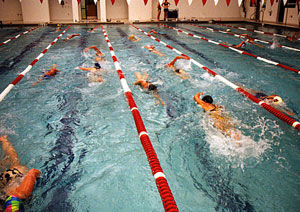
|
| ©Courtesy of Water Technology, Inc. |
| At the water's surface, swimmers breathe in a mix of volatilized disinfection byproducts, including some recently discovered to form in chlorinated swimming pools. |
As people have increasingly turned to swimming for its health benefits, a flurry of research relating swimming-pool-water treatment to potentially hazardous byproducts has come down the pike in the past year. Alfred Bernard of the Catholic University of Louvain (Belgium) and colleagues have published data in the past several years that connect early childhood exposures to indoor swimming pools with the development of asthma later in life. Higher chloramine levels in indoor-swimming-pool air have been correlated with upper respiratory complaints from pool workers and swimmers, and chloroform and bromodichloromethane levels in swimmers' and workers' urine have been suggested as markers of trihalomethane exposures (DOI: 10.1021/es070084c).
Trihalomethanes or trichloramine typically are blamed, says Thomas Lachocki, head of the National Swimming Pool Foundation. But in the new work (funded partly by the foundation), Jing Li and Ernest "Chip" Blatchley, III, of Purdue University find a fuller spectrum of DBPs with a technique called membrane introduction mass spectrometry (MIMS). From laboratory experiments and assessments of four indoor swimming pools, an outdoor pool, and a recreational water park, the researchers teased out evidence of several compounds, including trichloramine, dichloromethylamine, cyanogen chloride, and dichloroacetonitrile.
The authors are the first to report the formation of organic chloramines in pools, in addition to the inorganic chloramines and haloforms already known to be there. "Dichloroacetonitrile has been identified as a respiratory irritant, so it is possible that some of these newly identified volatile pool DBPs may also contribute to asthma observed in swimmers," says Susan Richardson of the U.S. EPA. She hypothesizes that the presence of dichloromethylamine - which is not a known DBP in drinking water - may be particularly significant. "I think this is a very important study, taking us beyond the inorganic chloramines and THMs," or trihalomethanes.
Although MIMS has the potential advantage of being portable, Richardson would like to see the spectra confirmed by gas chromatography/mass spectrometry. Christian Zwiener, who studies the effects of trichloramine on lung cells among other water-quality issues at the University of Karlsruhe (Germany), notes that it would be difficult to identify some of these compounds with either method.
Blatchley says that he and his colleagues plan to sample more swimming pools with a newly developed portable MIMS device that has real-time, sequential, and multiple sampling capabilities.
"The reality is that not a lot of research is done in the arena of public swimming exposures and health," says Lachocki. "The question [the new study] leads to really is, is this of toxicological significance?" Swimming has health benefits that need to be weighed against the risks of chemical exposures, he emphasizes.
Treatments to reduce DBP loads include circulating water through traditional sand filters and implementing UV light, a newer method that could reduce the precursors that would react with chlorine. The pools in Germany, which tend to use much less chlorine compared with the U.S., according to Zwiener, use flocculation methods or regularly replace pool water to avoid extreme DBP production. Many researchers who are focused on the DBP - asthma connection met in Belgium last month for a workshop to discuss the state of the science and where to go next.



...have been available in Australia for years, available in NA in the last 2 or so. Simple device that electrolyzes (splits) the salt in water (4000 PPM). No chemicals need to be added to water. The ionic Sodium and Chlorine reformulate quickly. Soft water to swim in, without much free chlorine.
This is nothing more than a market racket for chlorine suppliers.